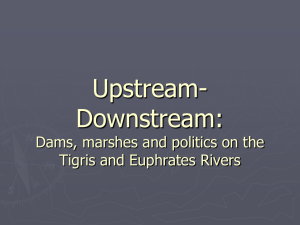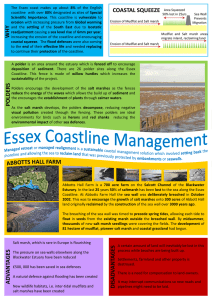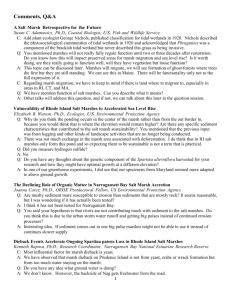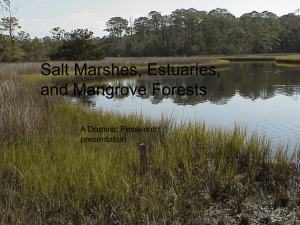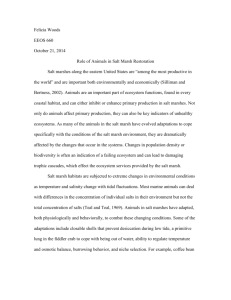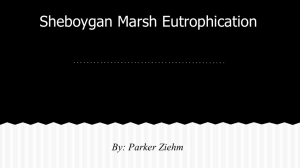More information on the Physical features of the Site: The
advertisement
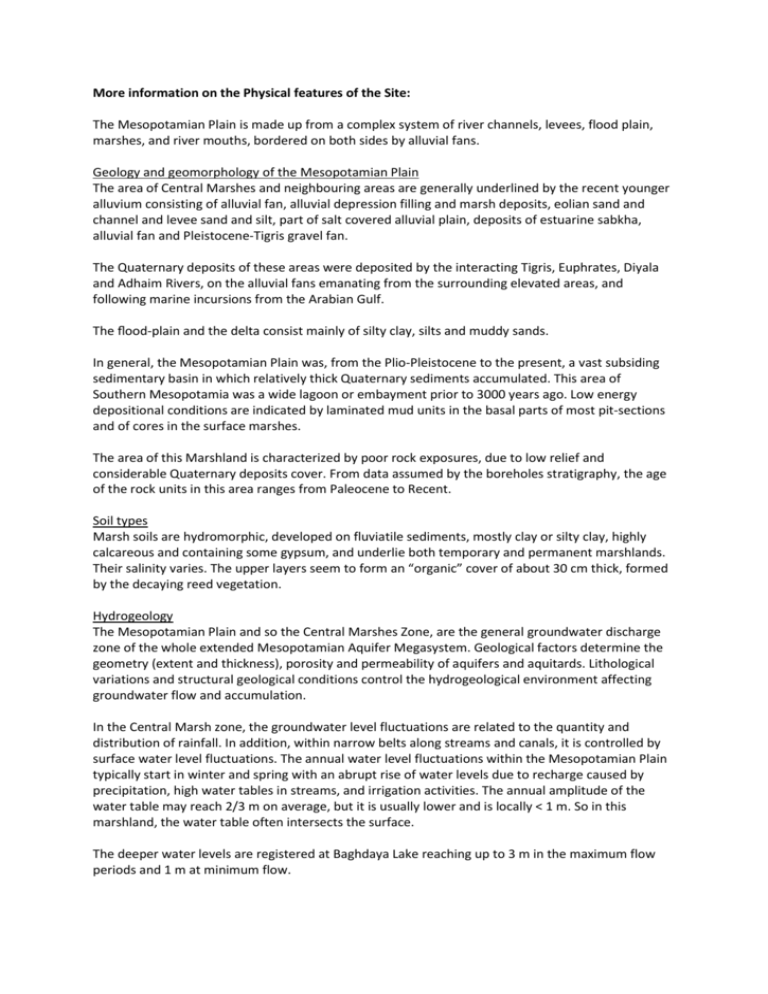
More information on the Physical features of the Site: The Mesopotamian Plain is made up from a complex system of river channels, levees, flood plain, marshes, and river mouths, bordered on both sides by alluvial fans. Geology and geomorphology of the Mesopotamian Plain The area of Central Marshes and neighbouring areas are generally underlined by the recent younger alluvium consisting of alluvial fan, alluvial depression filling and marsh deposits, eolian sand and channel and levee sand and silt, part of salt covered alluvial plain, deposits of estuarine sabkha, alluvial fan and Pleistocene-Tigris gravel fan. The Quaternary deposits of these areas were deposited by the interacting Tigris, Euphrates, Diyala and Adhaim Rivers, on the alluvial fans emanating from the surrounding elevated areas, and following marine incursions from the Arabian Gulf. The flood-plain and the delta consist mainly of silty clay, silts and muddy sands. In general, the Mesopotamian Plain was, from the Plio-Pleistocene to the present, a vast subsiding sedimentary basin in which relatively thick Quaternary sediments accumulated. This area of Southern Mesopotamia was a wide lagoon or embayment prior to 3000 years ago. Low energy depositional conditions are indicated by laminated mud units in the basal parts of most pit-sections and of cores in the surface marshes. The area of this Marshland is characterized by poor rock exposures, due to low relief and considerable Quaternary deposits cover. From data assumed by the boreholes stratigraphy, the age of the rock units in this area ranges from Paleocene to Recent. Soil types Marsh soils are hydromorphic, developed on fluviatile sediments, mostly clay or silty clay, highly calcareous and containing some gypsum, and underlie both temporary and permanent marshlands. Their salinity varies. The upper layers seem to form an “organic” cover of about 30 cm thick, formed by the decaying reed vegetation. Hydrogeology The Mesopotamian Plain and so the Central Marshes Zone, are the general groundwater discharge zone of the whole extended Mesopotamian Aquifer Megasystem. Geological factors determine the geometry (extent and thickness), porosity and permeability of aquifers and aquitards. Lithological variations and structural geological conditions control the hydrogeological environment affecting groundwater flow and accumulation. In the Central Marsh zone, the groundwater level fluctuations are related to the quantity and distribution of rainfall. In addition, within narrow belts along streams and canals, it is controlled by surface water level fluctuations. The annual water level fluctuations within the Mesopotamian Plain typically start in winter and spring with an abrupt rise of water levels due to recharge caused by precipitation, high water tables in streams, and irrigation activities. The annual amplitude of the water table may reach 2/3 m on average, but it is usually lower and is locally < 1 m. So in this marshland, the water table often intersects the surface. The deeper water levels are registered at Baghdaya Lake reaching up to 3 m in the maximum flow periods and 1 m at minimum flow. Groundwater quality Dissolved solids are transported by both ground and surface water. After humid seasons, when groundwater level is high (especially in irrigated areas without adequate drainage) surface water is often present in depressions. High evaporation subsequently increases the salinity in the shallow waters and soils in the marshlands. The chemical composition of ground water within the Mesopotamian Plain varies especially in the shallow zone. In the Central Marshes area, the groundwater composition is also influenced by seepage from surface watercourses and reservoirs and is relatively fresh. Under this shallow fresh water lies highly mineralized salt water with salinities of many tens of g/L. In particular, for the unconfined aquifers the salinity’s values in most part of Central Marsh is medium-high and the values are mostly within a range of 5000 to > 50,000 mg/l, or from water seldom used for irrigation (5000-10,000 mg/l ) to unusable water (10,000-50,000 mg/l) and brine (> 50,000 mg/l). Fluctuations of the water level The maximum flooded area of Central Marshes (calculated for the period 2000-2013) is 117,569 ha (one hundred and seventeen thousands five hundred and sixty nine); the minimum flooded area is 3,972 ha (three thousands nine hundred and seventy-two). By using the storage curves of the marshes (area versus elevation) that correlate the extension of the marsh and the stored volume with the water elevation level, as calculated in the “New Eden Master Plan for Integrated Water Resources Management in the marshlands area”- Volume II – Book 5, pg.24-30, the higher and lower levels of water above sea level have been defined as follows. Minimum water level = 0.4 m a.s.l. Maximum water level > 1.9 m a.s.l. More information on the Physical features of the catchment area: Geologic and Geomorphologic features of Mesopotamian Lowland Basin The complex of Central Marshes zone is contained within the Tigris-Euphrates river basin, in particular the Mesopotamian Lower Basin member. The geological and geomorphological features of this Basin are largely those of Mesopotamian Zone, which is a relatively flat terrain with a gradient of less than 10 cm per kilometer, extending from Baiji in the NW to the Arabian Gulf in the SE. The Mesopotamian Plain is considered to be a huge aggraditional (accumulation) geomorphologic unit, where the fluvial, lacustrine, and Aeolian landforms prevail. Estuarine and marine forms also exist, but these are restricted to the extreme southeastern reaches of the plain. The main geomorphologic units of the aggraditional fluvial origin are: terraces, alluvial fans, flood plains of major rivers and their distributaries, shallow depressions, marshes and lakes, and sabkhas. From the geomorphologic viewpoint, the Euphrates zone is the shallowest unit of the Mesopotamian Zone. The basement is generally 7-9 km deep. Three main stratigraphic subdivisions are recognized based on their relative ages; namely: Pleistocene, Late Pleistocene – Early Holocene, and Holocene. The main Pleistocene sediments are represented by river terraces, alluvial fans and fluvial sediments. The Pleistocene – Early Holocene Units include sheet run-off (sheet run-off is the broad, relatively unconfined down slope movement of water across sloping terrain), gypcrete and slope sediments. While the Holocene Units include sediments of different origins, such as fluvial, lacustrine, marine, estuarine, aeolian and anthropogenic. The Holocene sediments are also found in the modern sedimentary environments of the Mesopotamia Plain. The presence of Holocene marine sediments has been confirmed in the Southern Mesopotamia Plain, indicating the influence of marine inundation during early to mid Holocene. Such a marine transgression has reached as far as Amara City, on the eastern side and Nasiriyah City, on the western side, about 200 Km north of the present day northern shoreline of the Arabian Gulf. During the Quaternary Period (and even earlier), the basin was continuously receiving sediments, originated from the erosion products of the Zagros Fold Thrust Belt and the Arabian Platform, through active deposition of fluvial systems. Thus, the infill sediments of the basin are essentially of fluvial, deltaic, and lacustrine origin. These sedimentary facies may replace each other, both horizontally and vertically at local scales. The exposed Pre-Quaternary formations around the Mesopotamia Plain have variable lithology and range in age from Late Eocene to Late Pliocene. More information on the Hydrological values: Describe the functions and values of the wetland in groundwater recharge, flood control, sediment trapping, shoreline stabilization, etc. The hydrology of the entire lower Mesopotamian river system, including the Central Marshes, is impacted by a number of factors including the annual flooding during spring which raises the water level in the marsh to its peak between March and May. Water levels then drop gradually toward their minimum in the dry summer season. The natural flood cycle has been severely changed starting in the 1970s until the present time. All countries in the Tigris-Euphrates basin have constructed huge hydraulic structures over various parts of the major rivers. These include dams, reservoirs, barrages and regulators which give the operators of these structures a high level of control over water. Despite this, the hydrological data still show similar behaviour, although less in magnitude and duration. In addition to their direct economic benefits to Marsh dwellers and surrounding communities, the marshes also provide natural functions such as flood control, prevention of saltwater intrusion, water temperature regulation, water purification and erosion control. They also act to moderate the local climate, with the influence being felt as far south as Kuwait. Coastal fisheries in the northern Gulf were dependent on the marshes as spawning and nursery grounds. These fisheries have declined significantly following the destruction of the marshes. Historically, these wetlands were a main source of freshwater for human consumption, supplying communities living in and surrounding the marshes. Destruction of the marshes has had severe human health consequences as a result of the loss of clean water and the degradation of sanitation standards. Hydrogeology and groundwater characteristics In Iraq, fourteen main aquifers/aquifer groups have been identified and defined based on its relationship to geological and geochemical formations in 2006. At present, these 14 Aquifers/Aquifer Groups have been redefined into 22 and renamed as Aquifer Subsystems that are grouped into 5 main Systems, delineated on the basis of the physiography, geology, topography and tectonical/structural evidences. The Central Marshes has the characteristics of Aquifer n.2, the so called “Mesopotamian Aquifer System” that covers an area of approximately 110,000 km2 (one hundred and ten thousand), and is included between the Tigris and Euphrates rivers. The plain is very gently dipping and in the eastern side the aquifer is bound/fed by the Foothill Zone Aquifer Group. The elevation is really low; about 2 m above sea level near Basrah. Quaternary deposits originated by the interacting fluvial sediments of Tigris and Euphrates are the foundation, the base of the Mesopotamian Aquifer Mega-system consisting of several partly independent aquifer systems or sub-systems. The aquifer Subsystem is characterized by the presence of several overlying aquifers that may be unconfined or confined at times. The Subsystem 2B where the complex of Central Marshes is located, comprehends that part of the Mesopotamian Plain between the Tharthar Lake and the Shatt Al-Arab area. It is characterized by a general converging flow towards the center of the plain that secondly turns to south east taking the waters into the Gulf. The aquifers present in the Quaternary deposits are mainly composed of layered bodies of poorly sorted material, from gravel to sand inter-bedded with clay and silt creating heterogeneous lenses that allow a hydraulic sharing in horizontal and vertical directions. The formation is composed mainly of limestone and dolostones (containing clay and marls) weathered due to its surface proximity and characterized by good permeability. Hydrology The Euphrates River is currently able to flood approximately 25% of the former 1970’s conditions and large portions of the southernmost part of these wetlands are now covered by water and vegetation. Central (Qurna) Marshes, along with the Hammar Lake, provide most of the wetlands area where Marsh Dwellers once fled from and are now returning to. The main northern inflows of the marsh are the Buteirah and the Areedh Rivers branching off from the Meymuneh River, the largest diversion from the Tigris River in the region, plus some other inflows, which are anyway intercepted by the Al Ez River. The right hand distributaries of the Tigris used to terminate within the Central/Qurnah Marshes region, providing these with waters throughout the year, but mostly during the flood season. Hydrologically, the Central Marshes receive water from both the Tigris River to the north and the Euphrates River to the south. The outflow of all of the distributaries discharging from the right bank of the Tigris north of Qalat Saleh was captured through a human made canal located along the northern boundary of the Central Marshes, the Glory River. In the last decade the connection between the Tigris branches and the Central Marshes was re-established. The outflows of the wetland are directly linked with the Euphrates through inlets that were constructed along the left levee of the river as a result of the New Eden Master Plan for Water Resources Management in the Marshlands of Southern Iraq (Phase 1 - 2004-2006, Phase 2 - 20072009). Surface water quality/water depth Data obtained from a recent survey (January 2014) show that water temperature is on average around 11.3°C; water depth at the site is about 2 m; salinity is around 2.2 ppt. Average pH value is 8.13; DO average value is 6.8 and these values are within the river and tributaries/lakes and reservoirs water quality standard limits, as set by the Iraqi national legislation (Law No. 35 of 1967 Standards for Protection of Rivers from Pollution and subsequent amendments). More information on the Ecological features: Historically, the Central Marshes comprised a vast complex of mostly permanent freshwater marshes, with scattered areas of open water, located to the west of the Tigris River and to the north of the Euphrates River (going through Basra, Thi-Qar, and Maysan provinces) and represented many diverse habitats from seasonal to permanent marshes. The Central Marshes can be described as three main areas: Baghdadiya marshes, north of Chibaish city, Abu Zirig marsh to the northwest; and the northern marsh area, which is recently flooded thanks to the opening of the Buteira canal from the north and to the particularly favourable conditions of the winter 2013-2014, that has brought considerable amounts of water to the area. The satellite images below are showing the comparison between the flooding conditions of the Central Marshes as of July and December 2013. Figure 1: Central Marshes in July 2013 Figure 2: Central Marshes in December 2013 Baghdadiya marshes (a location inside the wide Central Marshes system, located specifically in the southern part of the wide marsh complex) used to have many open areas and deep water (more than 3 m); today the water level is lower than in the past and this (in addition to other causes) has also provoked an increase in salinity turning the water brackish. In the most recent survey (January 2014), the average depth of the site is 3 m; there are reed beds in the lake with dense plant-cover and the reed that is getting to spread more in the middle of the lake. This could be due to the increased availability of water in the central marshes area in general. The vegetation cover includes very dense submerged and emergent vegetation, and in particular very dense reed beds and patches of reeds (Phragmites australis). Small beds of reed mace (Typha domingensis) and Schoenoplectus litoralis are also occurring through the site. The open-water area is characterized by submerged plants (rooting and floating hydrophytes). Seven inlets from the Euphrates feed Baghdadiya marshes and they serve as an outlet when the water level in the Euphrates falls below the level of the marshes. Due to the sharp reduction in water levels in the Euphrates during 2009 and 2010, the Ministry of Water Resources, in collaboration with the local governments, constructed an embankment on the Euphrates in early summer 2010 and diverted the water flow completely towards the Central Marshes. Abu Zirig, (a location inside the Central Marshes complex on its western side; historically it is considered as belonging to the Central Marshes) is a freshwater marsh with good water flow and discharge. The water source is from the Al Gharraf River, a branch of the Tigris, and controlled by the Kut regulator. Water depth ranges from 0.5 to 1.5 m or more in the main rivers and waterways. It is close to Al-Islah city, southeast of Nasiria city. This area has quite intense human activity and disturbance such as reed harvesting, fishing, and bird hunting. Abu Zirig marsh is well known for the presence of dense vegetation in some areas, mainly Phragmites australis and Typha domingensis. It features a canal running from north to south that is approximately 2 m deep and bordered on both sides by reedbeds of 2-3 m or more height. This marsh seems to be less affected by dramatic changes such as drainage and turning of the marsh into dry soil because of continuous water availability. The northern area despite the recent flooding and the appearance of new marshland patches and vegetation is characterized by a more human-shaped landscape with a major presence of waterlogged areas and irrigated graminoid crops. Data collected in the period 2005-2010 has shown the following biodiversity features that characterize the site. Four main habitat types were observed in the Central marshes overall: 1- Inland running water, river or canal, 2- Inland standing water- aquatic communities- rooted submerged vegetation, free floating vegetation, and rooted floating vegetation, 3- Marsh vegetation- helophytic vegetation- reedbed, reedmace bed, and Schoenoplectus bed, and 4- Flooded communities – periodically or occasionally flooded land The wildlife that characterize the area and that gives value to this wetland ecosystem is formed mainly by waterbirds. There are globally threatened species such as the Marbled Duck (Marmaronetta angustirostris), the Basra Reed Warbler (Acrocephalus griseldis); the Greater Spotted Eagle (Aquila clanga), the Eastern Imperial Eagle (Aquila heliaca); near threatened birds such as the Ferruginous Duck (Aythya nyroca), the Pallid Harrier (Circus macrourus), the Eurasian Curlew (Numenius arquata) and the Black-tailed Godwit (Limosa limosa); restricted range species such as the endangered Basra Reed Warbler (Acrocephalus griseldis) and the Iraq Babbler (Turdoides altirostris); a number of biome-restricted species belonging to the Biome Sahara-Sindian Desert: White Tailed Lapwing (Vanellus leucurus), Spotted Sandgrouse (Pterocles senegallus), Egyptian nightjar (Caprimulgus aegyptius), White-eared Bulbul (Pycnonotus leucotis), Basra Reed Warbler, Iraq Babbler and Dead Sea Sparrow (Passer moabiticus). In addition the endemic race of Little Grebe (Tachybaptus ruficollis iraquensis) breeds widely in the area. The southern marshes lie at the centre of the distribution of an isolated subspecies of Smoothcoated Otter Lutrogale perspicillata maxwelli. Its status and distribution have been unclear due to confusion with the Eurasian Otter Lutra lutra, which also occurs in the region. Recent surveys have confirmed the presence of Smooth-coated otter in parts of the southern marshes for the first time since the 1950s-1960s and it is likely that this species occurs in the Central Marshes too, as well as other parts of the Tigris wetlands and marshes on both sides of the Iran-Iraq border. Some notable common mammals found during the KBA surveys (and according to local reports) were: Rüppell's Fox Vulpes rueppellii, Jungle Cat Felis chaus and Wild Cat Felis silvestris. Due to the availability of food and shelter, it seems that the Central Marshes provide good habitat for the endangered Euphrates softshell turtle Rafetus euphraticus. Tessellated Water Snake Natrix tessellata (Least Concern but with decreasing population) was also found. Fifteen species of fish were found in the area. Species of economic importance, according to Coad (2010), are: Acanthobrama marmid, Alburnus mossulensis, Carassius auratus, Cyprinus carpio, Cyprinion kais, and Heteropneustes fossilis. Additionally the following species of conservation concern that are also economically important are: Acanthopagrus latus, Aspius vorax, Carasobarbus luteus, Luciobarbus xanthopterus, Mesopotamichthys sharpeyi, Liza abu, Liza klunzingeri, and Tenualosa ilisha. By a regular check of fish catch it was observed that introduced and invasive Tilapia sp. have been released or somehow reached the area. By the end of the survey period, Tilapia sp. formed the majority of the catch for most fishermen in the Central Marshes, displacing many of the native species. More information on the Ecosystem services provided by the Site: The current socio-economic values of the Central Marshes are as reported in the Table below (source: Iraqi Marsh lands - Integrated UNAMI UNCT White Paper, 2011). In addition to these general values there are also historical and cultural values of extraordinary importance because of the presence of the Marsh Arabs Tribes. Table 1: Main ecosystem services associated with the Iraqi Mesopotamia marshlands Service Sub-category Examples Provisioning services – the goods of products obtained from Marshlands’ ecosystems Food Crops Livestock Capture fisheries Shrimp, yellow-fin sea-bream, khishni Aquaculture Cyprinids, grass carp, shellfish Wild foods Waterfowl (coot, teal), desert monitor Freshwater for drinking, cleaning, cooling, and transportation (canoeing and boating) Freshwater Fiber and fuel Paddy rice, great millet, dates, vegetables and fruits Asian water buffalo, cattle, sheep, water-buffalo milk and yogurt Fiber Reeds for housing and mats; date palm wood Fuels Reeds, crude oil, cattle dung Biochemical Potential use of Marsh flora extracts, native herbs for pharmaceuticals and pest control Genetic materials Resistance and breeding of native plant and animal species Regulating services – the benefits obtained from the Marshland ecosystems’ control of natural processes Moderation of the national rainfall patterns and control desertification and dust storms Climate regulation Water regulation Hydrological flows Storage and retention of water flowing from Euphrates-Tigris system upstream and tidal flow downstream; Permeable clay and silt facilitates recharge of the recent alluvium aquifer Water purification and waste treatment Removal of harmful pollutants from water by trapping metals and organic materials; soil microbes degrade organic waste rendering it less harmful Erosion regulation Reeds, grasses and estuarine vegetation retain soils and sediments Natural hazard regulation Marsh areas naturally absorb seasonal floods and tidal surges; moderation of drought at a local scale Pollination Habitat for bees and birds, the key pollinators of economically important crops Cultural services – the non-material benefits that Iraqis obtain from Marshlands ecosystems Ethical values Customs, oral traditions, knowledge and rituals attached to the use of the land and rivers; Iraqi tangible and intangible cultural heritage; an area of global importance Recreation and tourism Canoeing, bird and wild-life watching, recreational fishing, archaeological site visitation, Marsh communities Aesthetic Globally significant natural beauty Educational Science, cultural awareness, specialized vocational training, public awareness of national, regional and global importance Supporting services – the underlying processes that are necessary for the production of all other ecosystems services Soil formation Retention of sediment, recycling and supporting the health of the ecosystem Nutrient cycling Returning phosphorus, sulfur and nitrogen to Iraq’s atmosphere, water and soils More information on the Factors (actual or likely) adversely affecting the Site’s ecological character: Past factors that have affected and modified the site’s ecological character and its surrounding area are certainly the extensive drainage that the whole marshland complex of southern Iraq has experienced. Historically, the marshlands constituted a chain of almost interconnected permanent and seasonal marsh, shallow and deep lake complexes that flowed into one another and mudflats that were regularly inundated during periods of elevated water levels. During periods of high floods, large areas of desert were seasonally under water. Consequently, some of the formerly separate marsh units would merge together, forming larger wetland complexes with a great variety of habitats and ecological features. In the past centuries the marshlands area occupied about 16,000 km2. The deltas of Euphrates and Tigris dispersed their waters in these lands. After flowing out of the marshes, the Euphrates took a unified course crossing the town of Al Zubayr and ending up in Khor Al Zubayr. During the years and throughout the centuries, the area of the marshes shrank and increased according to the intensity of the seasonal floods of the two rivers and according to the ability of the rulers of Iraq to control the water of the rivers. The state and area of the marshes remained unchanged for centuries, until after the Ottoman Reign. The most important developments happening to the marshes of southern Iraq were the establishment of modern controls of the water of the Tigris and the Euphrates. This led to a decrease in the great floods that affected Iraq and consequently the area of the marshes in Iraq. In addition, the irrigation projects played an active role in determining the courses of the Tigris and Euphrates and their branches. A program to dry out the marshlands was implemented in the early 1990s. Many hydraulic works were constructed to achieve this goal. As a result, by 2002, the marshes occupied only 14% of their original (1970s) size. The following image shows the marshes prior to the re-flooding initiated in the spring of 2003. Conditions in 2002 can be considered the lower limit of the marshlands’ extent. At that time, only 1,600 sq km of marshes were still alive, mostly because some flow was still coming into Huweizah Marshes from Iran through the Hawr Al Azim. Present threats that have been identified for the Central marshes refer to: disturbance and overexploitation of natural resources, like for instance reed harvesting, fishing, or hunting. Main threats that have caused the global decline of the endemic species in this region are: pollution from pesticides and fertilizers, pollution from other chemical types and from oil extraction activities, by- catch in fishing nets and intentional killings by locals due to lack of awareness and the belief that this animal contributes to the fishing harvest decline, since its diet is based on fish. Figure 1: Southern Iraqi marshland extent (including Central Marsh) (in blue) in 2002 before the reflooding as compared to the historical marshland extent (in red)
